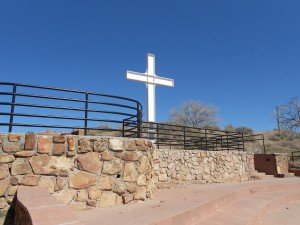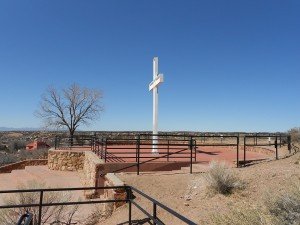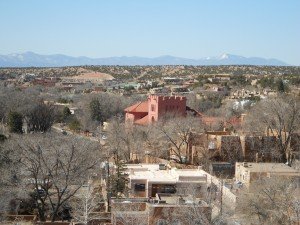Santa Fe New Mexico is a top tourist destination and draws thousands of people annually from around the world. Visit Santa Fe during the summer months and you’ll no doubt hear dozens of languages being spoken. Santa Fe has one of the richest histories of any city in the United States and to really learn about it’s roots you need to hear the famous story of the Pueblo Revolt.
Thank you for reading this post, don't forget to subscribe!What is referred to as the pueblo revolt is known in history as the Pueblo Revolt of 1680. This event was THE turning point in old Santa Fe history. If you have the opportunity to visit what is called “The City Different“, there’s a very visible reminder of the Pueblo Revolt that can be seen on top of a hill just a few blocks north of the Santa Fe plaza. The walk up the hill takes perhaps 15 to 20 minutes and you’ll enjoy a splendid view of not only the city below but also the Sangre de Cristo Mountains behind you to the northeast. On the top of this hill is a large white cross which is known as The Cross of the Martyrs. The cross is twenty-five feet tall and commemorates the death of 21 Franciscan friars and numerous Spanish colonists during the Pueblo Revolt of 1680. The Cross of the Martyrs was dedicated during Santa Fe Fiesta in 1920.

The Pueblo Revolt of 1680 was a repudiation of Spanish rule by the pueblo Indian tribes of northern New Mexico. It was the culmination of decades of forced conversion and servitude applied by the Spaniards. The church was at the center of the rebellion being the instrument for converting the local pueblo Indians to Christianity. There was also a good deal of harsh punishment against those pueblo Indians accused of sorcery and just about anything connected with their centuries old spirit worship.
Whipping and being put in prison was not unusual punishment during these times. While the Pueblo Revolt may appear that it was set off by one distinct event in 1680, that really wasn’t the case. The anger was building up over decades. The harsh rules and punishments just came to a head in 1680. It just so happened that in 1680, the pueblo people had a galvanizing force from a leader named Pope (pronounced po-pay). Pope, who was just recently released from a prison, was the pueblo Indian who set up a network of messengers to communicate the detailed plans for revolt to neighboring tribes. Interestingly enough, even tribes that shared a mutual distrust of other tribes joined together for this assault. This was probably the key reason that the rebellion was successful.
With this being the case, the Franciscan friars were especially targeted by the pueblo Indians during this bloody uprising. As mentioned above, twenty-one friars were killed and this represented the vast majority of friars in New Mexico which at that time was named Nuevo Mexico.

The Pueblo Revolt was an act that violently addressed the grievances that the pueblo Indians had against the Spanish colonists. As such, it’s an interesting event with many twists and turns. One of the best books on the subject is The Pueblo Revolt of 1680: Conquest and Resistance in Seventeenth Century New Mexico by author Andrew L. Knaut. This fine book not only describes what took place during the revolt but also describes in great detail the rules and punishments meted out by the Spaniards against the pueblo peoples. It also describes in detail the interaction between the Indians and the Franciscan friars. It’s an excellent source of information about this historic rebellion.

The Pueblo Revolt of 1680 expelled the Spaniards from Nuevo Mexico for a period of twelve years. The Spaniards were successful in reentering the territory in 1692 under the new leadership of Diego de Vargas Zapata Lujan Ponce de Leon. De Vargas was successful in persuading twenty-three pueblos to rejoin Spain’s empire. While there was some resistance from a few pueblos, in the end de Vargas succeeded and Santa Fe itself was reoccupied with settlers by 1694.
A key factor that aided de Vargas’ reconquest was the fact that there was trouble between the pueblo tribes during the twelve years of Spanish absence. Pope himself pushed the tribes to burn and destroy anything Spanish including all crosses. Marriages that occurred during Spanish rule were not recognized. In general, the pueblo tribes split up after the revolt and confusion reigned. It was in this atmosphere that the Spaniards under de Vargas returned in force in 1692 with the result being a bloodless reconquest.
Two additional articles we’ve published that you’ll find interesting are The Palace of the Governors and The Santa Fe Trail and Plaza.
(Photos are from author’s private collection)
